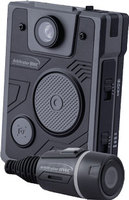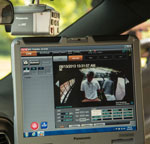6 Major Concerns To Address When Implementing A Body Worn Camera Solution
Posted by Ben on 4th Aug 2015

There Is No Simple Solution to Body Worn Cameras
Recently, we have seen a large push for Body Worn Cameras for police departments. Body cameras provide a higher level of transparency with regards to police officers’ interactions with the public. Departments which have implemented body cameras have already begun to reap the benefits – fewer use of force complaints, complaints being dropped when the accuser sees the footage, and more insight into exactly what happened in use of force incidents. Additionally, when people know the interaction is being filmed, many situations are outright avoided as both the officer and the citizen involved can have a tendency to act more appropriately when they know they are being filmed.
Regardless of the reasons for choosing to implement a body worn camera, be it mandated or by choice, the fact is many departments have recently or will soon implement body worn cameras. With federal and state funding becoming available for these cameras, many departments are now burdened with having to assess many different options to decide which camera solution will be best for their department, and are quickly learning that implementation of body worn cameras is hardly about the camera alone. When implementing a wearable camera, aspects such as the capabilities of the evidence management software as well as where such a large amount of data will be stored should be addressed before the final decision of what to purchase is made.
There is a lot of discussion happening about what the best solution for storage is, and this will change on a case by case basis depending on the individual requirements of each department. Some departments will see cloud solutions such as Microsoft’s Azure Government Cloud as a perfect solution as it requires significantly less maintenance and implementation on the part of the department, while others see local storage or a hybrid solution as being the way to go.
In this post, I’ll discuss some of the most important questions you should address before deciding on which body worn camera solution to choose.
Who will maintain our data?
This question changes dramatically between cloud and local
storage. With cloud storage, this is mostly a matter of “who will handle
redaction” and “who will share these files with the person who needs them (such
as the DA)”. When it comes to video redaction, this can be a full time job for
many departments, every second of video needs to be analyzed for redaction, and
with more than a few officers recording all of their interactions with the
public, the amount of video which will require redaction can grow
exponentially. The job of sharing evidence with necessary people is much
simpler with cloud than on-premise storage, as most cloud software has this
functionality build in, but with on-premise storage this usually consists of
burning a DVD, which will require not only time but the cost of all of the DVDs
used for evidence.
When it comes to on-premise storage however, this question also encompasses security of the network and server, maintenance of the server such as repairs and backing data up, burning evidence to DVDs to share it with the necessary parties, maintaining an audit trail to ensure that the integrity remains intact, and more. This quickly becomes a full time job in and of itself, if not requiring multiple people for larger departments with heftier requirements. With a cloud solution, things like server maintenance and security are taken care of for you, and in some cases they may even do a better job of keeping your evidence secure.
When analyzing the cost of cloud storage vs on-premise, be sure to take into account the salary of any additional employees you might require to maintain an on-premise solution, as this can have a large effect on the TCO (total cost of ownership) of the solution (qualified IT professionals don’t come cheap!), in addition to the cost of the server itself.
What is the cost of the storage?
The cost of cloud storage varies pretty wildly, but in a lot of cases you aren’t simply paying for storage. With a model like Taser’s Evidence.com, you are paying $55/month for a SaaS (software as a service) model, so only a minimal 20GB of storage is included. Baltimore City assembled a group to assess different solutions for body cameras, and they estimated that each officer would accumulate approximately 1.19 Terabytes per year. So while additional storage is available at a cost of $1.50/GB/Year, at the rate of 1.19TB/year the total cost per officer per year for extra storage alone would be about $1,480.50. Add to that the monthly fee of $55 and the total cost per officer for the cloud service alone comes to about $2,140.50. So while you get more than just storage, the cost per officer gets pretty high when you consider how much data you will actually need to store. On the plus side, you have a reliable cost model and know exactly how much this will cost you, whereas with local storage you could fall victim to hardware failures causing unexpected costs.
Why should I consider cloud?

One of the major benefits to cloud storage is that you don’t need to worry about hiring somebody to set up a server, implement security measures, maintain an audit trail, constantly be available for server maintenance, etc. This relieves your department of a lot of burden, and in a lot of cases cloud datacenters use redundancy, so that if one server is down, it will not result in downtime to your services. When your local system goes down, you will be out of luck until your system administrator gets it back online, potentially leading to no way to process your evidence when it needs to be processed. Many people hear the word “cloud” and think of the infamous “leaks” that have happened with various cloud providers, however those were usually cases of insecure or compromised passwords; local storage is susceptible to the same issues, however unless you hire a team of security specialists you might not achieve the same level of security as someone like Microsoft with their Azure Government Cloud, making it easier for a hacker to gain access to your data and potentially corrupt it.
That sounds great, why should I consider local storage then?
First and foremost, some states may put restrictions on the use of grant money. For instance, local mandates could require that you use local storage, or that you cannot use grant money for cloud storage. In these cases, money is king and you simply might not have a choice.
In some cities and towns, an IT department is already in place, and local storage is already utilized for video storage for other sources of evidence, such as in-car video. In these cases, it might make more sense to just add some hard drives to increase your storage and keep all of your data in one place. Also, if you have the IT infrastructure in place, on-premise storage may give you more control over your data and allow for faster transfer of the video evidence to your server.
What are the capabilities of the software?

Each camera solution will have different software to manage the video files. In some cases, as with Wolfcom, the video is not stored in a proprietary format and so any software can read the video, and in that case you aren’t stuck using their software. Some cameras, such as Panasonic’s upcoming BWC, use proprietary video format and as such you will need to use their software, SafeServ, to manage your video. This isn’t necessarily a downside, their software is extremely robust, has been used for a long time with the Arbitrator system, which will provide Arbitrator users with a Unified Evidence Management Platform, allowing all of your video evidence to be processed the same way. This is a great solution for Arbitrator users, as it won’t require further training to use the software, and the wearable camera simply another source of evidence. In short, you need to know that the software you will be using will do exactly what you need it to with a user friendly interface. It will be a huge bonus if you can use the same software for all of your sources of video, as this will do a lot to simplify things for your department
And then there’s the camera.

Each company producing cameras will have slightly different features. How rugged is the camera? What is the resolution? What is the field of view? How sturdy is the clip? Do you have the ability to turn off audio recording if your state does not allow officers to record audio? Can you take still shots while recording video? Does the camera allow for GPS tagging and meta information to be added in the field? These, among many others, will be features that you need to analyze to figure out what your department will require. Some systems do not provide a point of view camera, is this necessary for your department? We've put together a comparison chart with some of the more popular brands of cameras, click here to check it out.
As you can see, there is a lot to consider when deciding on a body worn camera solution, and your department will likely have to live with the choice you make for a long period of time. Once you have gathered your requirements and done some research, consider a pilot program to thoroughly test different products to find the best fit. Remember, if you require assistance, Telrepco is only a phone call away!



